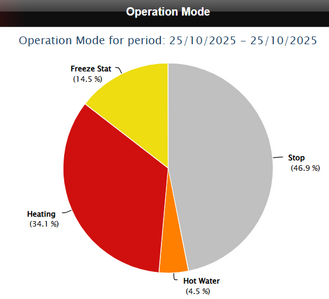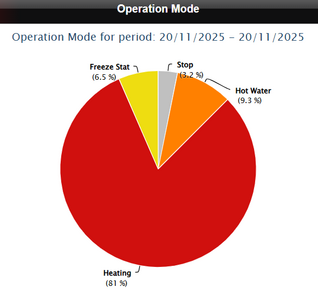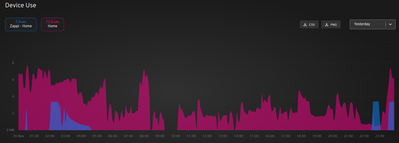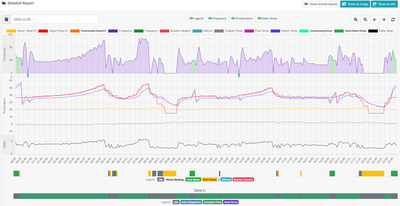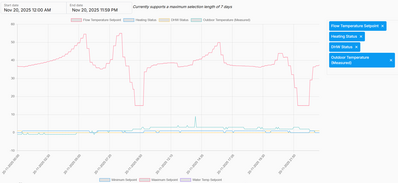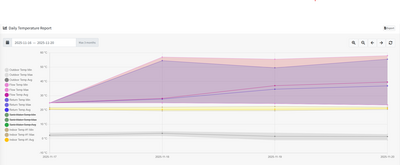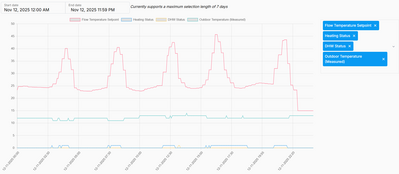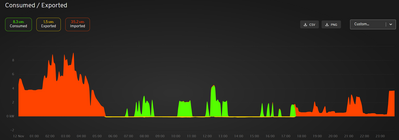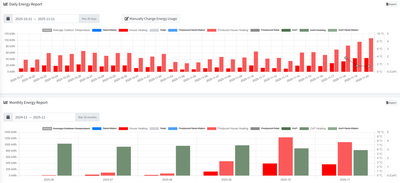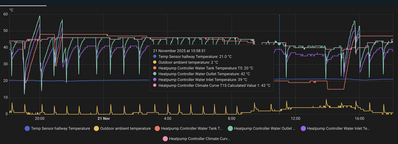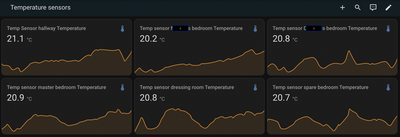Posted by: @jamespaMy wife's nephew has installed a smart shower which can be time limited (and presumably monitored/controlled) from his phone…
A system like that seems susceptible to significant amounts of misuse, perhaps even abuse.
Sounds great.
105 m2 bungalow in South East England
Mitsubishi Ecodan 8.5 kW air source heat pump
18 x 360W solar panels
1 x 6 kW GroWatt battery and SPH5000 inverter
1 x Myenergi Zappi
1 x VW ID3
Raised beds for home-grown veg and chickens for eggs
"Semper in excretia; sumus solum profundum variat"
I received confirmation this morning that my Greener Home Reward from my mortgage provider has been approved, so the additional £2,000 of support towards the cost of the installation (on top of the BUS grant award) is now a reality, or at least it will be when the payment is received within the next 4 weeks.
This isn't a widely known scheme, from what I can see, and I only became aware of it via Octopus' heat pump information page making reference to it. There are several banks which operate schemes like this, each with slight variations, for people with residential mortgages with them.
It's a retrospective application process, so you can only start the process post-installation, at which point you have to provide a copy of the invoice for the works, proof of payment and confirmation of the MCS certification for the work. Once approved, they repay the grant award into the account that you have your mortgage direct debit set up from.
The award covers different types of work, such as solar PV installations, but a heat pump installation qualifies for the maximum amount of £2,000.
Relative to the BUS grant, these still seem to be largely under the radar. The company I used to install the heat pump weren't aware of it, for example, but it's well worth being aware of if you're a qualifying customer. I've linked to a few below, for info:
https://www.lloydsbank.com/mortgages/help-and-guidance/eco-home-hub/eco-home-offers
https://www.barclays.co.uk/mortgages/greener-home-reward/
https://www.halifax-intermediaries.co.uk/sustainability/green-living-reward.html
130m2 4 bed detached house in West Yorkshire
10kW Mitsubishi Ecodan R290 Heat Pump - Installed June 2025, currently running via Havenwise.
6.3kWp PV, 5kW Sunsynk Inverter, 3 x 5.3kWh Sunsynk Batteries
MyEnergi Zappi Charger for 1 EV (Ioniq5) and 1 PHEV (Outlander)
Given that this thread ultimately turned out to be a diary of an installation process from initial quotation onwards, I'd always intended to return to it to provide periodic updates on how the system was performing. Given that it was installed in late June, there wasn't much scope for meaningful updates while the heat pump was initially only providing hot water to the house. Sad as it sounds, I actually welcomed the cooler post-summer weather kicking in so that I could start to assess what living with a heat pump would be like in reality.
I posted a few updates in response to other relevant threads on here, but today feels like an appropriate day to return to this thread with an update. The reason for this is that today is the first day since the pump was installed that the measured outside air temperature reported by the unit dipped below zero. It's been getting close in the last few days, but it took until this morning to actually see a figure below zero.
I've learned over the last few months that one of the 'routine' bits of feedback when you mention heat pumps in general conversation is that there seems to be a general belief from those who know little about them that they won't heat a UK home in really cold weather. Given such, there was a certain satisfaction this morning to waking up in a house where the room temperatures were approaching 22°C on the various digital hygrometer displays (cheap Amazon purchase, but giving decent accuracy) dotted around the house as part of my post-installation system monitoring. The requirement is set at 21°C at that time, but there's usually been a bit of an overshoot at that time from the aimed-for early morning boost while the overnight cheap rate electricity tariff is still running.
So while getting ready for work in the toasty warm house while staring at overnight frost on the conservatory roof, it felt like today was some sort of 'landmark' in that any residual fear about whether or not the heat pump system could do the job in this house had been fully exorcised. The technology works (and it still slightly blows my mind that something can be so effective by essentially stealing heat from outside air that's uncomfortable to stand around in for too long) and the 'budget price' heat pump installation done for a net outlay of £2,850 is so far doing exactly what I hoped it would, and delivering a meaningful cost saving relative to last year to do so. We're still early into the heating season, so I guess there's potential for things to go wrong as it progresses, but so far, so good.
So that's the 'cliff notes' version of the update. The more detailed breakdown of things is what I plan to shed a bit more light on when I get chance to add a few more posts, as the way in which the heat pump is delivering this performance, which is being driven by Havenwise control, is different to how I'd anticipated it would work, and also a little different to the 'low and slow' weather compensation driven methodology that I'd always expected to see in action.
One of my big frustrations to date with the heat pump system, in common with so many users on here, is the limited information that I could get from the native applications (in my case, MelCloud) to enable me to analyse things in more detail. The Havenwise app provides some additional data in this regard, but still very much at a summary level. This is no doubt perfectly fine for their typical user profile, but I have a natural inclination to want to analyse things far more than that, if only to improve my understanding of what's going on. It's only over the last four weeks that I've been able to improve on this, initially by requesting access to the Havenwise installer level data, and in the last two or three days by signing up for the MelPump app that other forum users have provided positive feedback on. Both are using only the data that MelCloud gives them access to, but are providing analysis that is much more helpful. The latter, in particular, is giving me a new level of insight and providing data snapshots which might prove to be of interest to other forum users, as it seems to indicate an operation profile that is very similar in concept to what the Octopus representative on RHH's latest video, featuring 5 of the 'big name' installers, was describing for the operation of their Cosy heat pumps.
Apologies if this has proven to be a somewhat vague initial post to re-start the thread. I'll get to the more interesting stuff ASAP.
130m2 4 bed detached house in West Yorkshire
10kW Mitsubishi Ecodan R290 Heat Pump - Installed June 2025, currently running via Havenwise.
6.3kWp PV, 5kW Sunsynk Inverter, 3 x 5.3kWh Sunsynk Batteries
MyEnergi Zappi Charger for 1 EV (Ioniq5) and 1 PHEV (Outlander)
So, moving onto the more analytical part of the update, the logical way for me to do this is to summarise how the evolving curiosity has developed over the post-installation period. Consequently, I expect this to be a long post, but hopefully one which is easy to follow for those interested in the content.
So initially after installation I had the standard access to the MelCloud reports, and the additional data from the Havenwise app to work with. The MelCloud information isn't useless, and does provide some intuition, but it's frustrating in that it provides only a visual picture of most information without any ability to see the underlying figures. You can't even hover over a particular point on a graph or table to see the value that is being reported, which is particularly annoying when trying to interpret energy consumption and output tables. The Havenwise app is more helpful in this regard, as it provides a CoP calculation, both separately for Heating and DHW and as a total. The limitation there is that this is always for a rolling 6 day period, so you can only scroll back in these 'blocks' which update on a rolling basis as each new day is added.
One of the more useful MelCloud outputs is the pie chart showing the heat pumps operation mode over a given period (the default options being last 24 hours, last 7 days or last 31 days). In the early days post-installation, the system was doing little more than provide timed DHW re-heats. Havenwise switches off the default hysteresis setting that provides continuous re-heating when the temperature drops too far below the requirement, which is a sensible thing to do, given the limitations of the DHW temperature reporting from the tank sensor, so I quickly got used to seeing graphs showing maybe 3% usage for DHW and the pump showing as idle for 97% of the day.
Things started to get a little more interesting when the system eventually started to provide some heating to the house, but I was intrigued by how little time was being used to produce heating. The idle status time continued to be a hugely significant chunk of the pie, often showing 50%+ idle times even as the temperatures dropped further, but whilst still maintaining the internal temperature requirement within the house, which would move by perhaps a degree or two in either direction around the set point. It was very obvious that the system was providing incremental heating to maintain the internal temperature, but in shorter, sharper blasts of heat than a continuous 'low and slow' operation.
This idle time profile continued, even when temperatures dropped in late October to the point where the freeze protection operation started to kick in (which I believe is when temperatures fall below 5°C), as the output from 25th October shows. The pump was still in idle mode for almost half of that day, yet doing exactly the job required for both Heating and DHW.
By a quirk of timing, the only time that I've seen anything like continuous usage from the heat pump has been when we've hit average temperatures approaching 0°C in the last couple of days, as shown below. However, when this analysis is rolled back over the last 7 days, there's still a sizeable chunk of idle time, so the 'almost continuous usage' profile only kicks in at an average daily temperature of around 1.5°C.
Even within this near continuous operation status, the operation of the heat pump isn't that of recognisable cycling from a low and slow heating operation. I've only seen this kind of profile in the usage from a sustained period of freeze stat operation overnight a few days ago. The heating is still being applied in more significant 'blasts' of operation than could realistically be described as 'low and slow' and this presumably then allows for the relatively prolonged periods of idle operation to be feasible, even in cold weather.
Havenwise offer two modes of operation which a user can choose between. Initially, I'd been on the default 'Option 1' as they refer to it, which attempts to utilise your energy tariff in how the pump operates so that it uses cheap rate electricity as much as possible, which rationalised to my why I'd been seeing this type of operation for heating initially. However, the limitation of this is that Havenwise can only apply this to your tariff rate timings, and has no visibility, or concept of, solar PV generation and battery storage, which means that the stated tariff rates aren't the true cost of electricity for much of the day. It is also unable to identify any periods of additional cheap usage periods, which usually arise from using smart charging on Octopus Intelligent Go, when Octopus decides to charge your car outside the stated cheap rate times, and drops the tariff to the overnight rate in those periods too. Consequently, towards the end of October I asked them to switch me onto the 'Option 2' charging, which they say uses a more 'low and slow' approach and ignores the tariff timings. I suspected that this would be a more efficient method of operation for me to adopt, and I've essentially been trialling it for the last 4 weeks. The big surprise I've discovered is that the overall profile of energy usage hasn't noticeably changed that much and, even though it's advised as "more of a low and slow" methodolgy, the reality looks very different to a low and slow weather compensated form of operation, as most of the purists on this forum would view it. For clarity, this is not a criticism of what Havenwise is choosing to do, as the end result looks to be very cost effective. It's just noticeably different to what I'd expected to see when I made the change to option 2, as the two modes look very similar when applied to my system.
The only 'negative' aspect I've seen from the results to date are that my CoP scores don't look particularly good for a newly installed system, albeit I'm seeing excellent cost savings on the limited heating season data I have available so far. Part of this may be down to the specifics of our property itself (if you followed the previous updates, you'll be aware of the design challenges thrown up by our conservatory) but I have also assumed that the 'short, sharp blast' approach also builds in some CoP inefficiency, which is compensated for by the periods of idle operation within the overall set-up, and it's this aspect that has prompted me to want to investigate further, purely out of curiosity.
There have been a few forum threads in recent weeks which have also contributed to me wanting to understand this further, as they've touched on the types of output I've been seeing from my own system, but more from a viewpoint of something being wrong with the system in question, or at least questioning whether it's supposed to be operating in that way. In particular:
https://renewableheatinghub.co.uk/forums/renewable-heating-air-source-heap-pumps-ashps/mitsubishi-ecodan-r290-10kw-performance/paged/3/#post-52729 relates to a very similar sounding setup to mine (same heat pump model, similar PV and battery setup), which has now been determined by the installer to be a faulty unit.
https://renewableheatinghub.co.uk/forums/renewable-heating-air-source-heap-pumps-ashps/do-heat-pumps-need-to-start-up-at-full-power/#post-52799 is a query from @toodles regarding power spikes at the start of a cycle which are entirely consistent with the usage spikes I see from my own system.
https://renewableheatinghub.co.uk/forums/renewable-heating-air-source-heap-pumps-ashps/10kw-heat-pump-run-in-247-data/#post-52934 relates to a user experiencing high energy consumption from their own 10kW heat pump (different manufacturer) and seeking comparable data from other systems.
In very general terms, some of the responses within these threads imply that the power draws being taken from the heat pumps should never reach the levels being reported, and yet I'm seeing similar, if not higher power draws from my own system which is operating in a cost effective way (I've deliberately avoided using efficiently here, due to the low CoP, but I would rank cost effective as more important than CoP efficiency in doing so). This resonated even further when watching the latest RHH video which referenced this type of operation with regard to the Cosy Heat pumps ( https://renewableheatinghub.co.uk/forums/renewable-heating-air-source-heap-pumps-ashps/british-gas-vs-octopus-energy-vs-heat-geek-vs-edf-vs-aira/#post-52939 - comment referred to starts at around 38:45 in the video).
I requested, and was granted, access to Havenwise's installer level data at the same time as I switched to Option 2, and this has been a great improvement in being able to look at what's going on a little deeper. However, this was caveated to advise that it is not primarily intended for end-users to access so isn't 'polished' in that regard (again, not a criticism, as I'm grateful to have access to it, but more as to provide context as to the intended purpose). However, it's only within the last few days of accessing the MelPump data for the first time that I've gained additional insight to feel like I'm reaching a point of comprehension that I'm confident enough to put onto a forum post on the subject. For absolute clarity, what follows is not intended to reflect any MelPump vs Havenwise preference and I view the two platforms, whilst technically being competitors, slightly differently. For me, Havenwise is a subscription based system primarily intended to run a heat pump system, which provides some statistical data to the user to support this. MelPump, in comparison, is primarily a subscription-based (following a free trial) reporting tool, offering additional reporting capabilities via the optional dongle and with a facility to use this data to tweak the heat pumps operating parameters. Both are proving to be incredibly useful to me.
So, in terms of trying to shed some light on the operation, let's begin by looking at my household usage profile for yesterday, which as we've seen from the above pie chart, is the closest day yet to the heat pump being in almost continuous operation.
The Sunsynk data is helpful in showing the overnight battery charging within the profile.
The data from the MyEnergi app is perhaps an easier overall visual snapshot of usage, with the battery discharge in green being distinct from the grid power draw.
There's also a MyEnergy view that separates out the car charging use from the other power draws, which is also helpful. On this day, the vehicle being charged at both ends is an Outlander PHEV, so the overnight usage is much less than when my wife's EV is plugged in to receive 40 kWh or so. You can also spot in this that there's a smart charging bonus period within this, as Octopus decided to provide 30 minutes of car charging at 10:30pm, prior to the official cheap period from 11:30pm to 5:30am.
As you can see, even after allowing for battery charging, car charging and high power domestic usage (e.g kettle, dishwasher and other large appliances) there are numerous spikes of high power draw that can only be attributable to the heat pump operation. This, based on some of the responses I've read in other forum posts, shouldn't happen within a 'low and slow' heat pump operation and tends to imply that something must be wrong with the system. However, from my perspective, this is usage in a system that is performing well, as far as I'm concerned.
The MelPump 'detailed report' is a great start point for looking at this, and it is some of the information within this that has shed new light on my understanding of what Havenwise is doing behind the scenes.
There's a lot to absorb within this picture, but the 'new insights' that are really helpful from it are the two sections at the bottom that show what the heat pump is doing at any point in time, and also what mode it is operating in when doing so. The top section also provides a very good visual in how hard the pump is working at any time, via the frequency graph in Hz, and also shows the defrost cycles done by the system.
The Havenwise installer data provides an equivalent visualisation to the middle section, which can be configured to include various other indicators. For ease of reference, I've filtered it to show only the target flow temperature being requested, plus the operating status of when heating and DHW are enabled, along with the measured OAT, which includes a couple of outliers in the plot. Relative to the MelPump data, this gives a much clearer visual as to what the system is being asked to do at any point in time, and the MelPump output then shows what the impact of this is in heat pump operation.
The immediate point that became apparent from seeing the MelPump data is that the system is operating in constant flow temperature mode when not idle, rather than following a heat curve or the auto-adaptation, which is the process by which MelPump is able to intervene in control if set up to do so. However, the flow temperature is far from constant in both graphs and the Havenwise graph in particular shows that their system is frequently making adjustments to this flow requirement to replicate a weather compensation type of process, but being 'pulled' by the internal heat requirement from the internal thermostat rather than being 'pushed' by the OAT driving a particular flow rate. It triggers these changes in requirement in a way that could only be controlled via an automated process, as it would be impossible to try to replicate this via manual control, so my interpretation of this is that it's a very sophisticated process being driven by Havenwise's algorithms. My heat pump is an R290 model. so is capable of operating at a wider range of flow temperatures than the earlier R32 versions, so perhaps the extent of flow temperature variation is unique to R290 pumps and the algorithms perhaps do something different with R32's.
There's another great visual output available in MelPump, which I think provides a good summary of the overall impact of this, which I've shown below.
Unlike some of the other data within MelPump, where I can get a historic picture, this table is only available for the period for which I've been signed up, so there's only 3 days actual data within it. However, I like the the summary picture that it portrays as it gives a very instant visual of the range of flow (reddish colours), return (blue/purple), room (yellow) and outside (grey) air temperatures with a line showing the mean value. For the 3 days so far the range of flow and return temperatures is consistently between 25°C and 57°C, but the mean figures are skewed towards the lower end of the scale, so on a day with an average OAT of 3.7°C the mean flow temp was 28.1°C and on the two colder days with average OATs of 1.6 and 1.5°C, the mean flow temperature was in the region of 37-39°C. Given the variability in operating temperatures being applied throughout the day, I find this to be a helpful overall summary of what the pump has done on a particular day.
My choice of dates to provide this summary is currently very limited, as some of the MelPump data is only currently available for the last 3 days, and the heat pump has been working for much longer periods of these days than has typically been the case prior to this. By way of comparison, below shows the equivalent Havenwise data for 12th November, when the heat pump was idle for almost half of the day, as per the first pie chart in this post showed, and when the mean OAT was circa 12°C.
As you can see, Havenwise asks the heat pump to operate in a very similar way overall, but for much shorter periods of time and with an overall peak flow rate requirement that is below the 57°C peak of 20th November. It is still providing heat in short, sharp bursts, rather than in a low and slow manner. The MyEnergi usage profile reflects this lower overall usage, but the relevant point is that there are still the peaks of power draw being taken by the heat pump, which some might view as red flags for how it's operating.
Ultimately, the measurement by which the success or otherwise of the heat pump will be measured is in terms of overall cost to run it, and I have to admit that there's still a period of adjustment going on in terms of seeing how much power the heat pump uses over a day in this cold weather (for which my 3 x 5.3kWh Sunsynk batteries feel hopelessly inadequate in terms of ability to store charge). However, rather than look at it in isolation in terms of "there's a lot being used" the assessment I have available is to look at what the heat loss calculations were projecting that I'd need to use at a particular temperature. The MelPump data now provides me with an average OAT figure for each 24 hour period that the system is running, so I'm able to compare the produced energy figure on a given day to the one from my amended heat loss calculation, which uses the information from the quotation data, but has been updated by myself to reflect subsequent changes in the house since then, such as the updated conservatory structure. Based on the 3 days of data I have available so far, the actual energy requirement is coming out at around 55-60% of the projected total, so in those terms the system is operating comfortably within what should have been expected, even though seeing daily consumption at these levels is still a bit of a shock to the system.
As a final graphical snapshot for what the system has done so far, I've attached below the MelPump analysis of my daily 30 day heating usage, along with a monthly snapshot of the heating performance since it was installed (input, output and Heating CoP by month). This highlights the relatively low CoP number that the heat pump is providing but, as hopefully explained above, I think that the efficiencies are being delivered by Havenwise in a different way, and is sacrificing CoP performance while still providing overall cost efficiencies.
If anyone has survived this far in the post, I hope it proves to be of interest. I'm posting it as an end user with no technical background in the workings of heat pumps. It is intended to provide a bit of context with regard to whether or not high short-term power draws from a heat pump are necessarily a bad thing, and I would argue that this isn't necessarily the case provided that the overall system is doing what's expected of it in performance terms and, so far, mine is doing exactly that.
In addition, it will hopefully also provide a bit of 'real-life' user experience for both the MelPump and Havenwise applications for anyone considering using them.
130m2 4 bed detached house in West Yorkshire
10kW Mitsubishi Ecodan R290 Heat Pump - Installed June 2025, currently running via Havenwise.
6.3kWp PV, 5kW Sunsynk Inverter, 3 x 5.3kWh Sunsynk Batteries
MyEnergi Zappi Charger for 1 EV (Ioniq5) and 1 PHEV (Outlander)
@sheriff-fatman that was a long read, but interesting 🙂
From what I can see Havenwise operates very similarly to Homely in that it does not adopt a low and slow approach in milder weather as you allude to (and when I say milder, when temps are around 6-9 ish degrees C outside). It operated the ASHP very differently compared with just setting a WC curve on the native controls which does coast along a bit more at lower overall flow temps.
I have wondered whether this is actually be design and some cunning way of reducing overall costs; the cynic in me makes me inclined to believe that it isn't actually cunning and it just operates a bit more on/off when it overshoots and undershoots the set temp, particularly when you try and unpick any evidence behind the marketing hype of this type of control.
We also adopted a similar approach with the features regarding tou tariffs and decided to knock it on the head and just exploit the battery storage during cheap periods instead. No regrets there. Again, using features within the controls themselves will lead to overshooting of IAT during the price dips which we didn't want.
Not a direct comparison to yours, but this month is the first time I can really compare our Midea with homely, versus our Midea just using native settings as our ASHP was initially set up mid Oct last year. This month looks set to be almost identical in terms of average temp, with a few days of really cold weather so should be a fair-ish comparison. Too early to draw conclusions with 9 days to go, and this cold period is really where it absolutely canes our energy consumption. My best guesstimate is that it is going to be close in terms of cost, but we do have a steadier IAT.
The data is utterly addictive as you say- I don't think I've ever spent this much time studying graphs, and wanting to create more. If it were me personally with your set up, I would absolutely look at using the native controls and linking Melcloud with home assistant which looks easily doable? This will surely give you all the graphs you desire, with the ability to hover over any point to like to show the numbers. You can store the data for as long as you like, and you can create and customise whatever graphs you like.
The most recent one I've set up shows the average rolling COP for each day in bar chart form, overlaid with the average OAT for each day, which I find truly fascinating.
Posted by: @bensonI have wondered whether this is actually be design and some cunning way of reducing overall costs; the cynic in me makes me inclined to believe that it isn't actually cunning and it just operates a bit more on/off when it overshoots and undershoots the set temp, particularly when you try and unpick any evidence behind the marketing hype of this type of control.
Maybe you are right to be cynical and maybe not, I would really like to know as it would help understanding how best to operate (in particular) oversized heat pumps.
Here is the counter argument, an argument which I readily admit may be incorrect in practice:
At mild temperatures, defined for the purpose of this discussion as temperatures at which the heat pump would naturally cycle, the heat pump is anyway going to be switching on and off. In this circumstance is it better to switch on and off frequently, or infrequently? What is the optimum trade off when comfort is considered? Does your heat pump naturally achieve that optimum - I would say highly unlikely.
Now heat pumps have various mechanisms and various configurable parameters to determine the cycle frequency, but so far as I am aware they dont (yet) have any learning capability. So the installer takes a guess and thats what happens.
Havenwise might learn, it certainly has the processing power to do so and so it might well do better than your installers random, probably uneducated, guess.
Heat pumps spend a lot of their time cycling. A typical right-sized heat pump in England will cycle at an OAT of ~11 or above. But plenty of heat pumps are oversized and the temperature at which they tart cycling will be correspondingly lower. So there is scope for optimisation.
I have no idea whether Havenwise does this, not whether it forces on/off at temperatures where the heat pump in question would not otherwise cycle. Therein lies some interesting future reverse engineering as people collect and share data..
4kW peak of solar PV since 2011; EV and a 1930s house which has been partially renovated to improve its efficiency. 7kW Vaillant heat pump.
Posted by: @benson@sheriff-fatman that was a long read, but interesting 🙂
Congratulations on being the first to make it to the other side intact (or at least being the first to admit to it!) I appreciate the response.
Logically, if I wanted more data, I could purchase the MelPump dongle which then will provide more data directly from the heat pump, and not rely upon MelCloud. Homely has always looked more complex to me (which is why I'd always intended to go with the 'non-hardware' Havenwise solution from the outset). I have the same technical fears about trying to set up either option, albeit I'm comfortable with the IT side of things. It's more the sticking sensors/plugs into bits of the heat pump which is the bit I shy away from.
130m2 4 bed detached house in West Yorkshire
10kW Mitsubishi Ecodan R290 Heat Pump - Installed June 2025, currently running via Havenwise.
6.3kWp PV, 5kW Sunsynk Inverter, 3 x 5.3kWh Sunsynk Batteries
MyEnergi Zappi Charger for 1 EV (Ioniq5) and 1 PHEV (Outlander)
@jamespa yes I guess it could be applying the logic of less cycling and indeed as you say our ASHP is operating more frequent cycles with the native controls in milder temps. Overshooting less and generally the outlet flow temp peaks are lower.
What I don't personally don't understand is, if that is indeed the operation and logic, why 3rd party controls manufacturers don't just explain it that way- here's the real world benefits of these controls compared with a WCC using native controls, even when fully optimised. Instead they use comparisons which seem to be designed to discombobulate and use "experimental" advertising. I'm not sure by offering some form of explanation as to how their algorithms can optimise a setup, that they'd be giving away any trade secrets as such.
In relation to the OPs setup, I wouldn't assume that Havenwise is saving and certainly the low-ish COP would probably result in me wanting to explore this more.
@sheriff-fatman (which is a great username btw- I assume inspired by Carter USM?!) -not sure whether you'd have to stick any probes/plugs anywhere. There seem to be a few integration options for Ecodans.
Posted by: @benson@sheriff-fatman (which is a great username btw- I assume inspired by Carter USM?!)
Well spotted.
130m2 4 bed detached house in West Yorkshire
10kW Mitsubishi Ecodan R290 Heat Pump - Installed June 2025, currently running via Havenwise.
6.3kWp PV, 5kW Sunsynk Inverter, 3 x 5.3kWh Sunsynk Batteries
MyEnergi Zappi Charger for 1 EV (Ioniq5) and 1 PHEV (Outlander)
If it helps, here's the sort of thing I have set up, so I can hover over any particular point to see the figures:
I've also got each room temp sensor linked.
And my most recent graph. COP is combined CH and DHW. I've only started plotting this over the last few days hence why there's some data missing.
Posted by: @benson@jamespa yes I guess it could be applying the logic of less cycling and indeed as you say our ASHP is operating more frequent cycles with the native controls in milder temps. Overshooting less and generally the outlet flow temp peaks are lower.
What I don't personally don't understand is, if that is indeed the operation and logic, why 3rd party controls manufacturers don't just explain it that way- here's the real world benefits of these controls compared with a WCC using native controls, even when fully optimised. Instead they use comparisons which seem to be designed to discombobulate and use "experimental" advertising. I'm not sure by offering some form of explanation as to how their algorithms can optimise a setup, that they'd be giving away any trade secrets as such.
I can think of a few possible reasons why the manufacturers of third party controls in general might want to be obscure about what they actually do
- if they explain what they are doing then people like you and me will simply set up the native controls to do the same
- they arent targeting people who understand it, they are targeting people who just want things to work
- they change their algorithm
- they dont know because the algorithm itself learns
- marketing blurb is written by marketing people, who know hot to obfuscate even if the product they are selling is basically rubbish
- the product is basically rubbish, at least for the application for which they are selling it
I dont thing (6) applies to Homely, Havenwise or Adia, but it does IMHO apply to many other third party controls. IMHO the whole heating control industry has brainwashed us over decades into the false idea that microzoning in time and space is beneficial (or even possible in a real household), and ignored the simple truth that turning down the flow temperature on your gas boiler so that it actually condenses, as it was designed to do, was by far the best thing you could do.
4kW peak of solar PV since 2011; EV and a 1930s house which has been partially renovated to improve its efficiency. 7kW Vaillant heat pump.
@jamespa some fair points. Personally we prefer how our native controls are operating our ASHP I think, and we may even be on track to make some savings, but certainly not much in it either way.
And agreed Homely was definitely not rubbish- I actually think it is what we needed for our ASHP at the time of first install, and was one less thing for the installers to mess up in terms of commissioning and getting it up and running. I also probably wouldn't have had the brainspace or understanding post install to do what we are doing now with HA.
Currently viewing this topic 2 users ( DavidAlgarve, Sheriff Fatman ) and 2 guests.
Recently viewed by users: Morgan 11 minutes ago.
- 26 Forums
- 2,323 Topics
- 52.1 K Posts
- 272 Online
- 5,979 Members
Join Us!
Podcast Picks
Latest Posts
-

RE: Hitachi Yutaki SCombi Heat Pump - Owners
Sim0n0. I also have the Hitachi Yutaki system. Also h...
By trebor12345 , 1 minute ago
-
RE: Solis S6-EH1P8K-L-PLUS – Why I Chose It and What I’ve Learned So Far
@batpred It should be easy to see in HA if ...
By Bash , 9 minutes ago
-
RE: MelCloud "Mixing tank temperature"
This post, on my 'diary' thread, might be of interest i...
By Sheriff Fatman , 19 minutes ago
-
RE: 10kw heat pump run in 24*7 data?
UPDATE: Very happy wife, since 24*7 I've actually had t...
By jeegnesh , 30 minutes ago
-

RE: Electricity price predictions
So bills going down following budget 1. The reducti...
By Jeff , 1 hour ago
-

RE: Heat Pump Training vs. Real-World Installation
Thank you for doing that, @editor, and for writing this...
By Majordennisbloodnok , 2 hours ago
-

Thank you for the reply. I think you are saying that w...
By trebor12345 , 4 hours ago
-

RE: Replacing my 18 month old Hitachi Yutaki ASHP
You could be right in that it's a region between the 2 ...
By trebor12345 , 4 hours ago
-
RE: A2A vs A2W: Which Heat Pump Would You Pick?
@editor Thanks Mars 😊. Metro Melbourne rarely g...
By SimonOz , 6 hours ago
-
RE: Home energy storage & battery register
Battery 1 x 5kWh Growatt, would consider a second when ...
By AgentGeorge , 7 hours ago
-
Slight correct to the above defrost behaviour as the fa...
By RadWhisperer , 8 hours ago
-

@grantmethestrength yes the do work like that - I'm usi...
By Sune , 8 hours ago
-
RE: Which 6kw to 8kw ASHP can modulate down the lowest ?
@editor the easiest way to find out is to look at the d...
By Damon Blakemore , 10 hours ago
-
RE: Battery with existing PV - regulations
I am curious... which inverter would you go with for so...
By Batpred , 17 hours ago
-
RE: Octopus Cosy Heat Pump Owners & Discussion Thread
@jamespa/p> Run starts at 11. It didn't do a defros...
By swwils , 21 hours ago
-
-
I had very helpful advice from several forum members ba...
By Steam Powered , 1 day ago
-

RE: Battery storage to run Heat Pump.
That comment is welcome, but can be read in two differe...
By Transparent , 1 day ago

